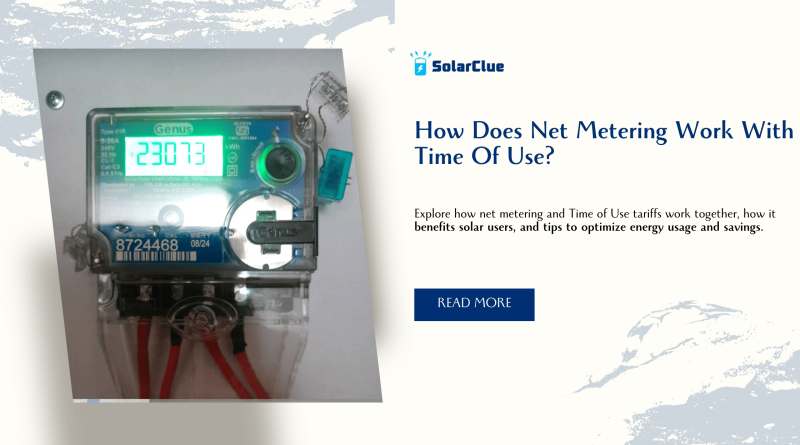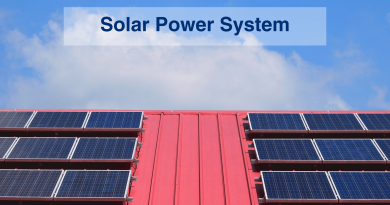How Does Net Metering Work With Time Of Use?
As renewable energy continues to grow, many consumers are adopting solar power systems and enjoying the benefits of net metering. In addition to net metering, some regions are introducing Time of Use (TOU) tariffs, which offer variable electricity rates depending on when energy is consumed. By combining net metering with TOU tariffs, consumers can maximize their savings by managing both their energy production and usage patterns.
In this blog, we’ll dive into how net metering and Time of Use tariffs work together, how it benefits solar users, and tips to optimize energy usage and savings.
Table of Contents
What is Net Metering?
Net metering is a system that allows solar energy users to send surplus electricity generated by their solar panels back to the grid. In return, they receive credits on their electricity bill, which can be used to offset the cost of energy consumed from the grid during periods when the solar system isn’t producing enough power (e.g., at night or during cloudy days).
Net metering acts like a virtual battery where the grid stores your excess energy and returns it when needed. The balance of energy exported to and imported from the grid determines your net bill.
What is Time of Use (TOU)?
Time of Use (TOU) tariffs is a pricing structure where electricity rates vary depending on the time of day. Typically, electricity is more expensive during peak demand periods (e.g., evenings when many people are home and using appliances) and cheaper during off-peak periods (e.g., late at night or mid-day).
In TOU, the day is divided into:
1. Peak Hours: Times when electricity demand is high and rates are the most expensive.
2. Off-Peak Hours: Times when electricity demand is low, and rates are cheaper.
3. Mid-Peak Hours: Intermediate periods when demand and prices are moderate.
How Net Metering Works with Time of Use (TOU)
1. When combined with net metering, Time of Use tariffs add a layer of complexity and opportunity to your energy bill. With TOU tariffs, the value of the electricity you export and import depends on when you send or use the energy. Here’s how it works:
2. Exporting Energy (Surplus Production): When your solar panels produce more energy than you use (typically during the middle of the day), the excess energy is exported to the grid. With TOU tariffs, the price you receive for this energy will depend on whether it is exported during peak, off-peak, or mid-peak hours. For instance, if you export energy during peak hours, you may earn a higher credit rate for that energy than if you export during off-peak hours.
3. Importing Energy (Grid Consumption): During times when your solar system isn’t producing enough energy (e.g., during the night or cloudy days), you will import energy from the grid. The cost of this imported energy also depends on TOU pricing. If you consume energy during off-peak hours, the cost will be lower, while consuming energy during peak hours will be more expensive.
Net Billing: At the end of the billing cycle, your utility will calculate the total energy you exported and imported. The credits you’ve earned for exporting energy are applied against the charges for the energy you’ve consumed. With TOU, this calculation becomes more dynamic, as the value of the energy exchanged varies based on the time it was used or generated.
Benefits of Combining Net Metering and TOU
By integrating TOU tariffs with net metering, consumers can fine-tune their energy production and consumption for maximum savings. Here are the key benefits of this combination:
1. Maximize Solar Export Value
With TOU, exporting surplus energy to the grid during peak hours can result in higher credits. Since solar systems typically generate the most energy during the day, solar users can take advantage of peak pricing by exporting excess power at the most valuable times.
2. Reduce Import Costs During Off-Peak Hours
By managing energy usage and consuming electricity during off-peak hours, consumers can avoid the higher rates of peak periods. For example, shifting electricity-heavy activities like running dishwashers or laundry machines to off-peak hours can help reduce overall electricity costs.
3. More Control Over Energy Savings
The TOU system encourages users to be more mindful of their energy usage patterns. By aligning their consumption with off-peak times and exporting during high-demand peak times, consumers can optimize savings and even potentially achieve a zero-bill scenario.
4. Environmental Benefits
TOU tariffs are designed to balance grid demand, reducing strain on the grid during peak hours. This encourages the use of clean, renewable energy like solar when it’s most beneficial to the grid, thereby promoting a more sustainable energy ecosystem.
Challenges of Net Metering with TOU
While the combination of net metering and TOU offers significant financial benefits, there are also challenges to consider:
Energy Consumption Timing: Shifting energy consumption to off-peak hours may not always be convenient. For example, evening times (when TOU rates are higher) may coincide with when people are home and using energy-intensive appliances, making it difficult to avoid peak charges.
Fluctuating Export Credits: The value of the credits you earn for exporting energy can vary significantly depending on the time of day. This can make it harder to predict the total value of the energy you export over a billing period.
Complexity in Billing: TOU tariffs introduce a more complex billing system, which can be confusing for consumers. It requires more careful monitoring of energy production, usage, and time-based rates.
How to Optimize Net Metering with TOU
To make the most out of net metering combined with Time of Use tariffs, solar energy users need to strategically manage their energy usage and maximize their credits. Here are some tips for optimizing savings:
1. Shift Consumption to Off-Peak Hours
Identify the off-peak hours in your TOU tariff and try to run energy-intensive appliances like washing machines, dishwashers, or electric water heaters during those times. This can significantly lower the cost of the energy you consume from the grid.
2. Install Energy Storage (Battery)
One of the best ways to take full advantage of TOU is by using a battery storage system. Batteries allow you to store the excess energy your solar system generates during off-peak or low-demand hours and use it during peak hours when grid electricity is expensive. This minimizes your reliance on the grid during high-cost times.
3. Monitor Solar Generation and Consumption
Use smart energy management systems to track the real-time production and consumption of electricity in your home. These systems can provide insights into your energy usage and help you make informed decisions on when to shift your energy consumption.
4. Use Smart Appliances
Smart appliances can be programmed to run during off-peak hours, helping you automate the process of reducing electricity usage during high-cost periods.
5. Use Time-Based Devices
Consider installing smart thermostats or timers to control appliances like air conditioners, water heaters, and lighting. These devices can help you reduce energy use during peak hours by automatically switching off appliances when they’re not needed.
Case Study: Example of Net Metering with TOU
Let’s consider an example of how net metering with TOU works in practice.
Scenario:
Solar Energy User: Owns a 5 kW solar system.
TOU Rates:
Peak Hours (4 PM – 9 PM): ₹7 per kWh
Off-Peak Hours (11 PM – 6 AM): ₹3 per kWh
Mid-Peak Hours (6 AM – 4 PM): ₹5 per kWh
Energy Flow:
Daytime (Mid-Peak Hours): The solar system generates 20 kWh. The user consumes 10 kWh, and the remaining 10 kWh is exported to the grid, earning credits at ₹5 per kWh.
Evening (Peak Hours): The user consumes 10 kWh from the grid at ₹7 per kWh, but the solar system isn’t generating electricity.
Nighttime (Off-Peak Hours): The user consumes another 5 kWh, but the cost is much lower at ₹3 per kWh.
Net Billing:
Credits: 10 kWh exported at ₹5/kWh = ₹50
Imports:
10 kWh consumed during peak hours at ₹7/kWh = ₹70
5 kWh consumed during off-peak hours at ₹3/kWh = ₹15
Net Cost: ₹85 (consumption cost) – ₹50 (export credits) = ₹35 net charge for the billing cycle.
In this scenario, the user has saved money by shifting some of their consumption to off-peak hours and exporting solar energy during mid-peak hours.
Conclusion
The combination of net metering and Time of Use (TOU) tariffs offers a dynamic way to manage your energy costs and maximize the financial benefits of solar power. By understanding TOU rates and strategically aligning your energy consumption and production, you can significantly reduce your electricity bills, even achieving a zero-net-energy bill in some cases.
However, to fully capitalize on the benefits, careful monitoring and management of energy usage patterns are essential.
Ready to Save on Electricity Bills with Solar Power?
With Net Metering, you can drastically reduce your electricity costs by generating your own solar power and sending any excess back to the grid. It’s time to harness the sun’s energy and make a positive impact on both your wallet and the environment!
At SolarClue, we make the transition to solar simple, efficient, and affordable. Whether you’re a homeowner, business, or institution, our team of solar experts will guide you through the process—from installation to maintenance—so you can start saving from day one.
🌞 Take the first step towards energy independence today!
🔋 Get your solar consultation now!
Contact SolarClue or call us at +91-888-4444-830 to explore the best solar solutions for your home or business.
Go Solar. Save More. Power Your Future with SolarClue!




